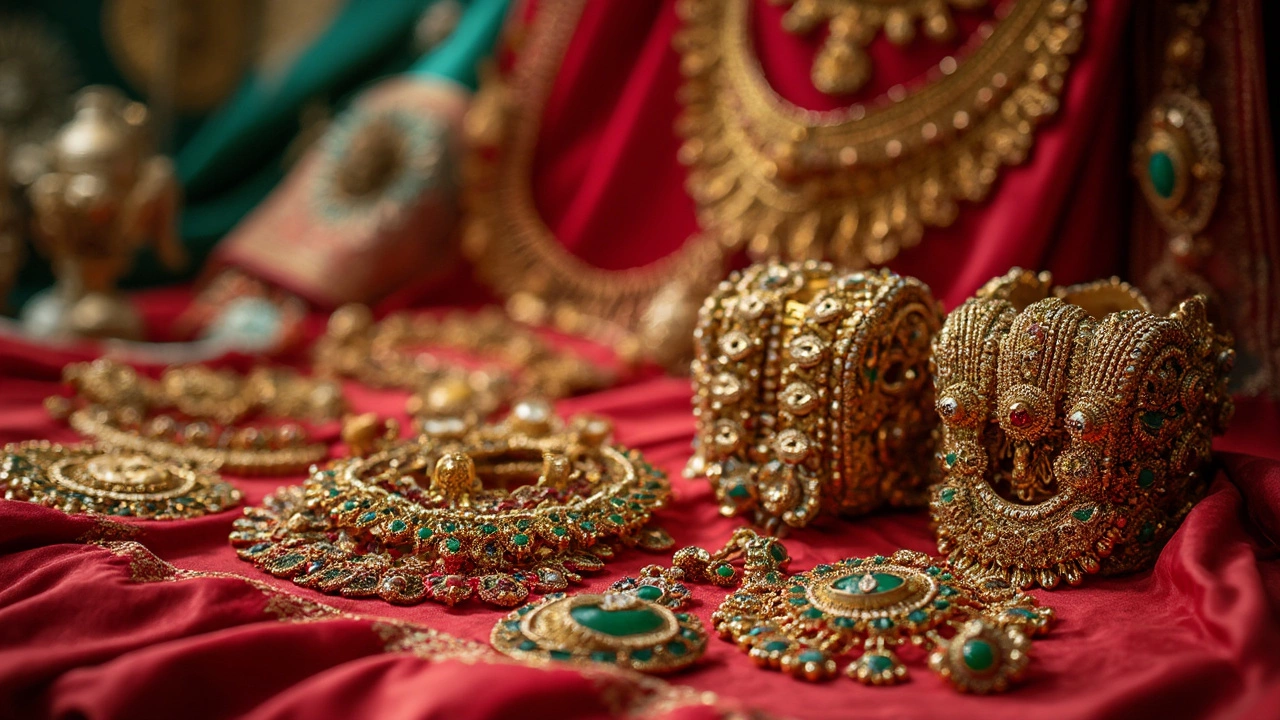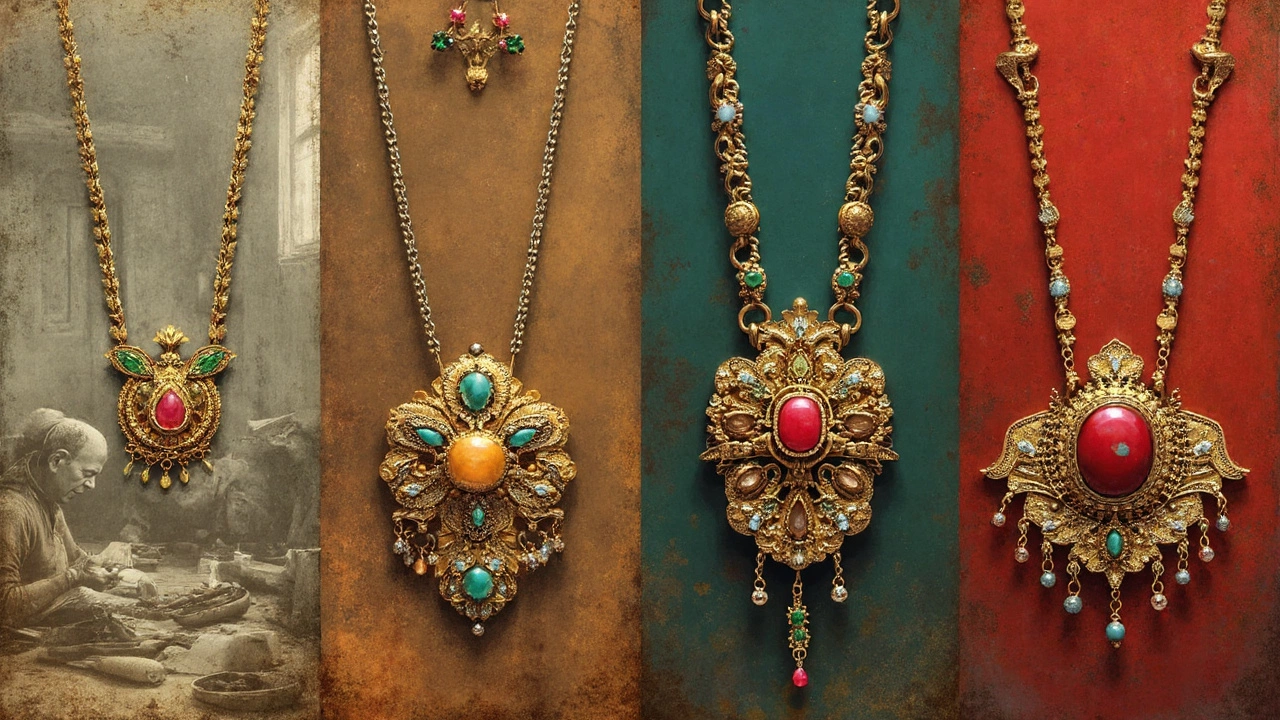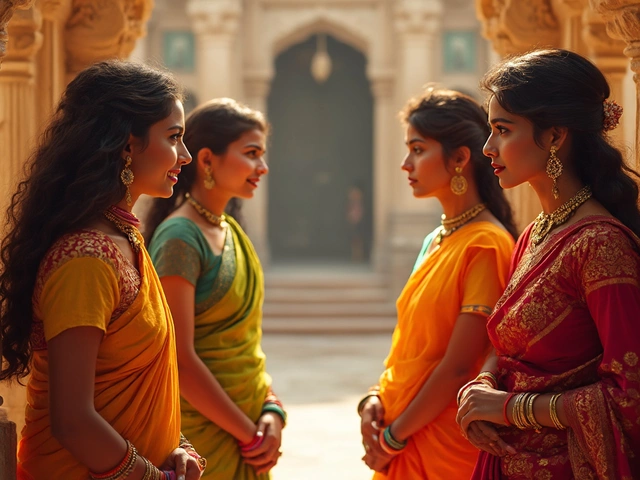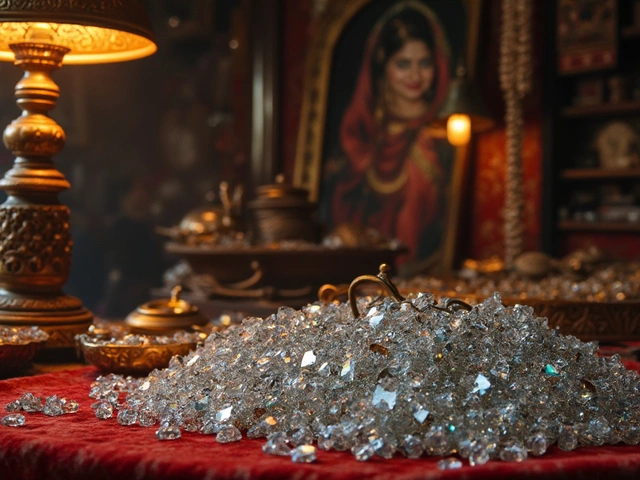
So you're curious if that vintage brooch you inherited from grandma is a hidden gold mine or just a lovely piece to admire? Let's get into why vintage jewelry might just be one of the smartest treasures to hang onto. These pieces aren't just shiny trinkets; they're like little time capsules, each whispering secrets of the past while potentially adding value to your future.
First off, it's important to know what makes vintage jewelry, well, vintage. Typically, we're talking about pieces that are at least 20 to 30 years old. But what really matters in the value department is the piece's history, rarity, and condition. Think of jewelry like wine: some just get better with age. But beyond age, it's all about the story—does it come from a renowned designer, like Cartier or Tiffany? Is it crafted from materials that are hard to come by today? These are the kind of things that collectors and enthusiasts are willing to pay top dollar for.
- Understanding Vintage Jewelry
- Factors Influencing Value
- Popular Vintage Jewelry Brands
- Tips for Investing in Vintage Jewelry
- Caring for Your Vintage Pieces
- Spotting a Good Vintage Deal
Understanding Vintage Jewelry
Alright, so here’s the lowdown on vintage jewelry. To be called vintage, a piece usually needs to be at least 20-30 years old. Now, that's not the same as antique, which typically refers to items over 100 years old. This means the vintage stuff could be anything from the 90s and earlier, offering lots of style variety!
But age alone doesn't make jewelry valuable. It's like finding an old toy in your attic. If it's a common piece, it might not be worth much. But if it's rare or connected to a major designer, now that's where you get the cha-ching. Brands like Cartier, Tiffany & Co., and Bulgari are huge names that collectors love because their pieces often come with top-notch craftsmanship and materials.
Let's talk about materials. Vintage pieces are often made from precious metals like gold and platinum, sometimes even in higher purities than what’s common today. And those gemstones? Well, earlier periods often used untreated stones, considered more authentic or desirable by collectors.
Here's a cool tidbit: Vintage jewelry can be a peek into history's fashion. For example, during the Art Deco movement (1920s-1930s), geometric shapes were in vogue, which is still loved today! So, owning a piece isn't just about style; it's like having a slice of history right in your hand.
Lastly, understanding the market can be your best tool. Having a piece from a sought-after era or style can increase its value. Vintage jewelry from the Victorian, Edwardian, or Art Nouveau periods often sees great demand. That means more interest and, potentially, a higher return if you ever decide to sell.
Factors Influencing Value
When it comes to making the most out of your vintage jewelry, knowing what drives its value is key. It's not just about how old a piece is; several factors come into play. First up, the brand. Pieces from heavyweights like Cartier or Tiffany tend to carry more clout—and cash value—than unknown makers. Why? Because these brands have a reputation for quality that collectors trust.
Next, consider the material. Is it adorned with diamonds, sapphires, or other precious stones? The quality and rarity of stones can dramatically affect value. Also, the metal matters—gold, platinum, and palladium usually hold up well over time and often appreciate.
Craftsmanship is another biggie. Attention to detail and the method used in creating the piece can set it apart. Handmade jewelry often tells a different, more intimate story than mass-produced items. Intricate designs not only impress visually but also speak volumes to a potential buyer or appraiser.
Condition is a no-brainer. Think about it this way: a scratch-free, well-preserved piece is a dream come true compared to something worn and faded. Original packaging and proof of authenticity add bonus points too.
Then there's rarity. Limited edition pieces or items that were once owned by famous folks can shoot up in value. It's the equivalent of finding a rare Pokémon card in your attic—except, you know, much more tasteful.
Don't forget market trends, either. What’s hot right now may not always be, but a sharp eye can spot cycles. Yes, you might notice a surge in demand for specific styles, like vintage Art Deco pieces, at particular times.
Popular Vintage Jewelry Brands
There's a whole bunch of vintage jewelry brands that are like rockstars in the jewelry world, and knowing them can seriously up your jewelry game. Some names are basically guarantees of value because they've stood the test of time and are synonymous with quality and craftsmanship.
First up, let's talk about Cartier. Often called the 'jeweler to kings,' Cartier's pieces are legendary. Known for their elegant designs and superior craftsmanship, Cartier vintage jewelry isn't just sought after for its style—it's a smart investment. Pieces like the Cartier Love bracelet or the Panthère collection have iconic status, both for their historical significance and enduring design. These are not just accessories; they're symbols of a rich history.
Tiffany & Co. is another giant in the vintage world. Famous for their classic elegance and those little blue boxes, Tiffany's creations have been adored by generations. Their classic styles, like the Tiffany solitaire diamond settings, continue to hold their value, sometimes fetching even higher prices than when they were new. The brand’s sterling silver designs are also a hit among collectors.
Then you have Van Cleef & Arpels, known for their unique, nature-inspired designs and innovative techniques. The brand’s Alhambra motif, first introduced in the 1960s, remains a timeless piece that collectors love. Van Cleef’s use of vibrant stones and exquisite craftsmanship makes them an exciting option for vintage jewelry hunters.
Finally, don't overlook pieces by Bulgari and Chanel. Bulgari is famed for its bold use of color and daring designs, often incorporating cabochon stones in ways that are thumping with creativity. On the other hand, Chanel blends fashion and jewelry effortlessly. Their camellia designs or jewelry from the Coco Crush collection are classic and maintain their charm over time.
In short, when you're in the market for vintage jewelry, keeping an eye out for these brands can ensure you're getting something that not only looks great but also stands a good chance of appreciating with time. Remember, each piece is a little slice of history, and that provenance can turn it into a valuable collector's item.

Tips for Investing in Vintage Jewelry
Investing in vintage jewelry can be a rewarding venture, both financially and aesthetically. But it’s not just about buying any old necklace or ring and hoping for the best. You need a plan, and here are some solid steps to help you navigate this glittering world.
First, do your homework. Educate yourself about different styles, periods, and materials. Pieces from the Art Deco period, for example, are highly sought after due to their bold geometric designs. Understanding what makes a piece unique or special will help you distinguish between a good buy and a common bauble.
When you're in the market, consider these pointers:
- Focus on Quality: Look for items in excellent condition. Scratches, missing stones, or signs of repair can reduce a piece’s value. Opt for jewelry that has been well looked after.
- Check the Provenance: Provenance is just a fancy word for history. If a piece comes with documentation that tells its story or confirms its authenticity, it can boost the piece's worth significantly.
- Look for Designer Labels: Much like clothing, a signature from a renowned maker like Tiffany, Cartier, or Van Cleef & Arpels can increase a piece’s value tremendously.
- Understand Market Trends: Pay attention to what’s trending. Some styles may be more in demand, making them a better investment.
It’s also wise to periodically have your collection appraised. This ensures you keep tabs on its worth and can decide the best times to sell if that’s in your game plan. Remember, investing in antique jewelry designs isn’t just about making a quick buck. It’s about appreciating art, history, and the little stories they hold.
Caring for Your Vintage Pieces
Got some vintage jewelry you're looking to keep in tip-top shape? Awesome choice, because how you care for these pieces can actually affect their value. Plus, maintaining them means you’ll enjoy them for years to come.
First off, you want to store your treasures the right way. Keep them in a cool, dry place away from direct sunlight. A jewelry box with soft lining is perfect, but if you’re using a drawer, wrap each piece in a soft cloth to avoid scratches and tarnishing from bumps and moisture.
Wearing them is half the fun, so a little bit of upkeep goes a long way. After you’ve showcased that sparkling necklace or flaunted a stunning brooch, give them a gentle wipe with a non-abrasive cloth to remove any oils or sweat that might settle on the surface.
Keep in mind, not all cleaners are your jewelry’s best friend. Some harsh chemicals can damage the vintage finish or delicate stones. It’s usually best to stick with a mild soap and water solution for cleaning metals and stones. Antique jewelry designs can be sensitive, so do your homework on what cleansers are safe for your specific type of jewel or metal.
- When in doubt, take your vintage gems to a professional for cleaning and maintenance. They can handle repairs that could go south if you try a DIY approach.
- Avoid exposing jewelry to perfume, hairspray, and other cosmetics. Always put on your pieces after you’ve finished with beauty products.
- Consider regular check-ups at a jeweler to ensure clasps and settings remain secure, especially for well-loved, frequently worn items.
Remember, these antique jewelry designs have already stood the test of time. With a little TLC, your gems will continue dazzling—and maybe even gaining value—for generations. Trust me, your future self (and even Eamon) will thank you for it.
Spotting a Good Vintage Deal
Finding a genuine vintage jewelry piece that doesn't break the bank is like hitting the jackpot for collectors and enthusiasts. But how do you know what makes a deal 'good'? Well, it all starts with doing a bit of homework. Become familiar with what typical pieces are worth. Check reliable sources like auction results or top vintage stores to understand what the going rates are for similar items.
A great place to start is to scrutinize the materials. Is it made of gold, platinum, or other precious metals? Authentic vintage jewelry often incorporates materials not commonly used today or crafted using methods that are no longer practiced. For instance, Victorian pieces might have rose-cut diamonds, which are quite distinct in their sparkle.
You should also consider the condition of the piece. This doesn’t mean you need something pristine; a bit of wear may even add to its charm. But watch out for major damages or repairs, as these can drastically reduce the value. Ask for a certificate of authenticity or a professional appraisal to confirm you're getting the real deal.
Designer names can be another big hint. Jewelry from renowned brands like Cartier, Tiffany & Co., or Bulgari tends to hold its value better over time. Keep an eye out for clear maker's marks or signatures, a surefire way to verify authenticity.
Pay attention to market trends, too. Certain eras or styles come back in vogue every few years, which can drive up demand and prices. Check out reputable sites and forums dedicated to antique jewelry to see what's trending now.
Finally, don’t overlook estate sales or auctions, where you might stumble upon hidden treasures. However, go in with a set budget, and a good sense of what you're looking for, so you don’t leave with buyer’s remorse!
Doing a little legwork before making a purchase goes a long way in nabbing a great vintage jewelry piece that could not only make you the envy of the party but also serve as a solid financial investment.




